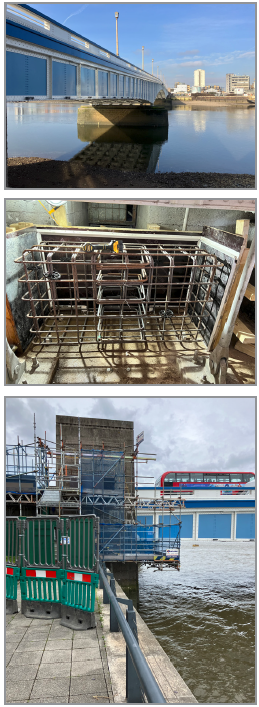Client: Richmond & Wandsworth Borough Council
Designer: Tony Gee
Principal Contractor: FM Conway
Works Commenced: ECI April 2023, On site June 2023
Works Completed: November 2023
Wandsworth Bridge, originally opened in 1940, is a vital transportation link in South West London, crossing over the River Thames. As part of a significant maintenance and refurbishment project by Wandsworth Borough Council to ensure the structure’s continued structural integrity and functionality, Freyssinet was engaged under an ECI contract to provide bearing survey, detailed survey on structural steelwork survey girders at bearing locations, design of a sychronised jacking system, two temporary guide bearings and 14 permanent bearings.
Freyssinet was subsequently engaged to replace the bearings on the bridge at the north and south abutments. The scope of works included:
- Design and supply of temporary and permanent bearings
- Widening of existing concrete jacking plinths including concrete repair.
- Fabrication and installation of strengthening steelwork in advance of bridge jacking
- Installation of structural steel temporary works and jack stacks at both abutments
- Jacking
- Hydrodemolition
- Removal and installation of bearings
- Removal of strengthening steelwork and painting remedials
The bridge was closed to all traffic for eight weeks while the works took place. Pedestrians and cyclists had access across the bridge during this phase.
The work sequence to each abutment was as follows:
- Strengthening of Girder connections (Structural steel)
- Widening of existing concrete jacking plinths
- Installation of temporary guide bearings
- Installation of cross girder restraints (Structural steel)
- De tension HDM bolts
- Jack the bridge
- Install new bearings
- De-jack bridge
- Tighten HDM bolts
- Remove Cross Girder Restraints (Structural steel)
- Painting remedial works to structural steel
Access to the works was by means of an underslung scaffold fixed to the underside of the bridge deck along the north and south abutments. Materials, plant and equipment were lowered and removed from the bridge deck onto the scaffold using a hoisting system, and trollies were used on the scaffold to move the bearings to the required location on the scaffold and then hoisted into position with chain blocks and lifting tables.
The scaffold was encapsulated to contain any waste from the construction works falling into the River Thames. All waste was controlled and contained within the scaffold ensuring no contamination into the river, and detailed ITPs for each construction activity ensured quality workmanship.
Grout strengths critical in the build-up of plinths prior to dejacking and final grout before reopening the bridge deck to give access to the PC to asphalt install joints. Testing and trials were done to find suitable grouts that would achieve the required strengths to meet the programme dates. The abutment area was encapsulated and heating installed to assist with the grout curing, and hydrodemolition to remove the existing bridge bearings reduced activity duration.
The working area was restricted within the abutment, careful planning with team and selection of the most suitable equipment was key. A good working relationship with the project team, FM Conway, Wandsworth Borough Council and Tony Gee (design engineers) was developed. There were numerous TQs based on the nature of the work, and they were dealt with efficiently and effectively by the team so as not to delay the works.
The project was delivered safely, of excellent quality and on programme.


